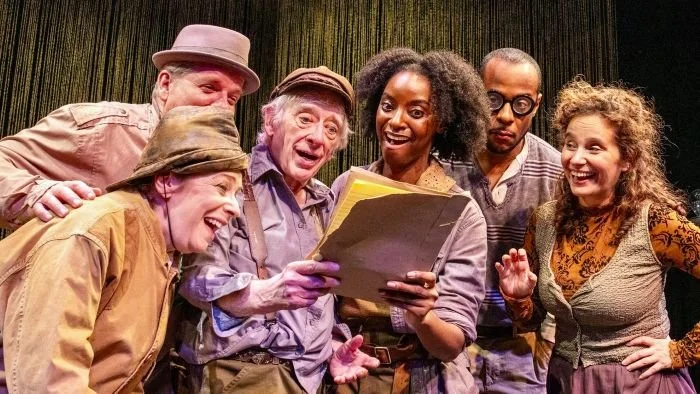A Midsummer Night’s Dream
Written by William Shakespeare; Directed by Bradford Cover
The Sheen Center for Thought & Culture | 18 Bleecker St, New York, NY 10012
October 11 - November 2
A Midsummer Night’s Dream—Shakespeare’s effervescent fantasia of entangled lovers, mischievous fairies, and metatheatrical folly—is, at its heart, a work of gossamer lightness and intricate construction, a comedy that pirouettes between realms of the real and the unreal, the regal and the rustic.Let us raise the curtain on a reimagining of A Midsummer Night’s Dream that bursts through the proscenium with riotous energy, theatrical mayhem, and a self-aware wink so broad it practically elbows the audience in the ribs.
The Resident Acting Company, a collaborative ensemble formed in 2018 with its roots steeped in the classical tradition, steps boldly into the limelight with its very first fully staged production—a madcap, metatheatrical romp through one of the Bard’s most beloved and oft-staged romantic comedies. The venue is The Sheen Center for Thought & Culture, but the setting? A garage. Or, rather, the ever-shifting, illogically whimsical confines of the character Peter Quince’s garage-cum-stage, imagined by the company’s fictionalized Mechanicals, in which Shakespeare’s enchanted tale of star-crossed lovers, meddlesome fairies, and play-within-a-play tomfoolery unfolds in fits, starts, and spasms of giddy invention.
Under the direction of Bradford Cover, the company’s artistic leader, six versatile performers frenetically embody no fewer than twenty roles among them, shifting costumes, wigs, and sensibilities at a breathless pace. What begins as the familiar rehearsal premise of Shakespeare’s most infamously inept troupe—the Mechanicals and their earnest attempt to stage Pyramus and Thisbe—sprawls outward into an absurdist fever dream wherein these same working-class thespians decide, against all odds and logic, to tackle the entire fantastical drama, from the court of Athens to the bewitched woods, in their cluttered workshop/garage strewn with the detritus of time, cluttered with vintage odds and ends (a porch swing, a sewing machine), and dotted with props that feel plucked from a secondhand shop’s clearance bin. The conceit is that we, the audience, are somehow complicit in this ad hoc rehearsal/performance hybrid—a theatrical mise en abyme that blurs the line between playhouse and play-pretend. The six valiant actors are enlisted to portray the astonishing twenty characters across intersecting storylines—a feat that we see in rehearsal demands razor-sharp clarity and dexterous tonal modulation.
And the cast is nothing if not game. Rachel Botchan dazzles with her crystalline delivery and arresting presence, navigating the roles of Hippolyta, Hermia, Titania, and Robin Starveling with formidable command. RJ Foster stands out as a virtuosic shape-shifter, vacillating between Theseus, Demetrius, Oberon, and the hapless Tom Snout with an energy that borders on manic genius, occasionally channeling his own frustration with a character-swapping frenzy that becomes part of the fun. Carine Montbertrand, meanwhile, all but steals the show with her Puck, turning the mischievous sprite into a tour de force of physical comedy, slapstick timing, and gleeful anarchic clowning. Her Snug and Cobweb are utter joys as well.
The rapid-fire character changes, while virtuosic, can become bewildering, particularly for audience members without a strong grasp of the source material. Austin Pendleton’s Bottom, charmingly dotty and delightfully wry, delivers his lines script-in-hand (and often out of order), something totally expected after a commanding Egeus early in the play. Anique Clements as Peter Quince provides that grounded presence to steer the unsteerable ship with clipboard in hand and exasperation in voice. Clements’ Peaseblossom is sweet, but her Helena is a masterclass pivoting off Foster’s Demetrius and Andy Paterson’s exquisite interpretation of Lysander. Paterson as Francis Flute, Mustardseed and Moth are miracles of nuance under the circumstances, but his Thisbe is truly a charmer for the ages.
There are clever touches throughout—an inspired use of a purple feather duster as the magical pansy that drives the play’s central love chaos; actors becoming human props; others miming instruments as they belt out PJ Ju’s original music. Even the famously clunky Bergomask dance is given a raucous update courtesy of choreographer Grace Ann Baresich, as the cast invites the audience to join in, clap along, and be swept up in the silliness.
Set designer Harry Feiner conjures a curious blend of garage-sale realism and theatrical whimsy: there’s a porch swing here, a vintage sewing machine there—symbols not so much of time-traveling wit as of conceptual inventiveness. Are we watching a rehearsal? A full-blown performance? A dream within a dream? The illusion shifts as quickly as the characters do, and at times, coherence is the price paid for cleverness…it takes that extra few seconds for the audience “who hasn’t been there for all the other rehearsals”.
Costumes by Evan Riley oscillate between historical flourishes, clownish absurdities, and dollar-store surrealism, often to charming effect, occasionally (purposely) making the character logic murky further. Masks, donkey ears, and party-store hats abound, and the lighting and sound (also by Feiner and Ju, respectively) attempt to delineate the layers of fiction, fantasy, and rehearsal—but these can become lost in the joyous whirlwind of meta-theatrical whimsy.
Ultimately, what The Resident Acting Company offers is less a faithful adaptation of Shakespeare than a backstage fever-dream about adaptation itself. It is a play about putting on a play, or perhaps a play about losing control of one. It is, in the end, as much an homage to the chaos of collaborative theater-making as it is a reinterpretation of A Midsummer Night’s Dream.
For those with a deep love of Shakespeare and a tolerance for self-referential antics, it may prove a delightfully unhinged evening. But for purists or those hoping for a more traditional rendering of the original text, this fractured fairy tale may feel more confusing than clarifying. Ultimately, what is in full bloom in all the Mechanicals’ theatrical gymnastics is the dream itself—that shimmering alchemy of poetry, misrule, and emotional truth that has enraptured audiences for centuries: the magic, the moonlight, and the metamorphosis.
The Resident Acting Company’s inaugural full production is nothing if not audacious. It wears its ambition on its sleeve, and in its best moments—when Bottom brays, when Puck prances, when Quince panics—it crackles with pure theatrical joy. Just don’t expect a straight path through the forest. This is midsummer by way of a luminous funhouse mirror.
Click HERE for tickets.
Review by Tony Marinelli.
Published by Theatre Beyond Broadway on October 20, 2025. All rights reserved.

